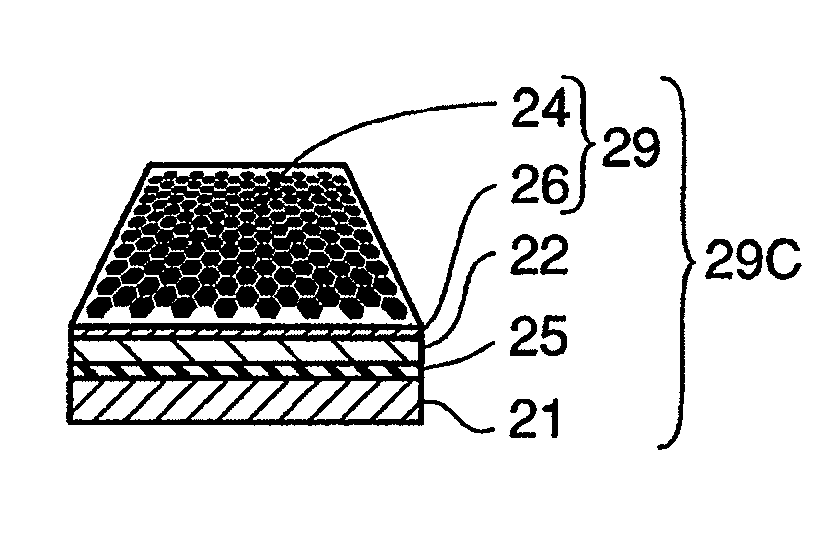Substrate, manufacturing method of substrate, semiconductor element, and manufacturing method of semiconductor element
- Summary
- Abstract
- Description
- Claims
- Application Information
AI Technical Summary
Benefits of technology
Problems solved by technology
Method used
Image
Examples
working example 1
CVD Growth of Graphene Layer and Dependency on Metal Catalyst
[0137]The graphene layer 24 and the graphene substrate 24A were fabricated according to the fabrication method shown in FIGS. 3A to 3E. A silicon substrate as the substrate 21 was thermally oxidized to form a silicon oxide layer (oxide layer 22), and then iron, nickel and copper as metal catalysts were sputtered to form a film, respectively. Using each of these metal catalysts, CVD growth of graphene was performed at a temperature of 1000° C., using methane as a carbon source. FIG. 4 represents a typical thermal profile before and after the CVD growth of graphene. The CVD growth was performed in the procedures as described below. The substrate comprising the metal catalyst film formed thereon was heated from room temperature to a CVD growth temperature under the flow of gas mixture of hydrogen and argon, and the CVD growth temperature was kept for about 10 to 60 minutes to age the metal catalysts. After that, flow of gas m...
working example 2
CVD Growth of Graphene Layer and Dependency on CVD Growth Conditions
[0138]Effects of CVD growth conditions on growth of graphene when the metal catalyst was nickel were examined. Examined growth parameters were temperature drop rate [° C. / min] after CVD growth, and methane concentration [% by volume] in gas mixture of argon, hydrogen and methane. The other CVD growth conditions including metal catalyst aging conditions and graphene growth temperature (1000° C.) were kept constant. Surface of grown graphene was evaluated with the use of an atomic force microscope, a scanning electron microscope or the like. Table 1 shows a relationship between temperature drop rate and methane concentration given to the growth of graphene, and summarizes features of graphene obtained under each condition. What is noticeable in the first place is that when the methane concentration was 0.25% by volume, little growth of graphene was observed no matter how much is the temperature drop rate, whereas when...
working example 3
Fabrication of Graphene Layer and Graphene Substrate
[0139]A graphene layer was formed on a comb-like electrode structure 33 as shown in FIG. 5A in the same manner as in the fabrication method shown in FIGS. 3A to 3E to fabricate a graphene substrate.
[0140]FIG. 5A shows a comb-like electrode structure in which a nickel catalyst layer 33 has been vapor deposited on a silicon oxide layer 32 / silicon substrate 31 by being defined by lithography. CVD growth of graphene was performed on this comb-like nickel catalyst layer 33 under the conditions indicated in working example 2. Observation with scanning electron microscope or the like revealed that graphene layers 34 including one- or two-layer graphene and of multilayer graphene were formed on the comb-like electrode structure (nickel catalyst layer 33) depending on the CVD conditions such as methane concentration and temperature drop rate. Consequently, the graphene layer 34 / nickel catalyst layer 33 / silicon oxide layer 32 / silicon substra...
PUM
| Property | Measurement | Unit |
|---|---|---|
| Electronic properties | aaaaa | aaaaa |
| Semiconductor properties | aaaaa | aaaaa |
Abstract
Description
Claims
Application Information
 Login to View More
Login to View More - R&D
- Intellectual Property
- Life Sciences
- Materials
- Tech Scout
- Unparalleled Data Quality
- Higher Quality Content
- 60% Fewer Hallucinations
Browse by: Latest US Patents, China's latest patents, Technical Efficacy Thesaurus, Application Domain, Technology Topic, Popular Technical Reports.
© 2025 PatSnap. All rights reserved.Legal|Privacy policy|Modern Slavery Act Transparency Statement|Sitemap|About US| Contact US: help@patsnap.com



